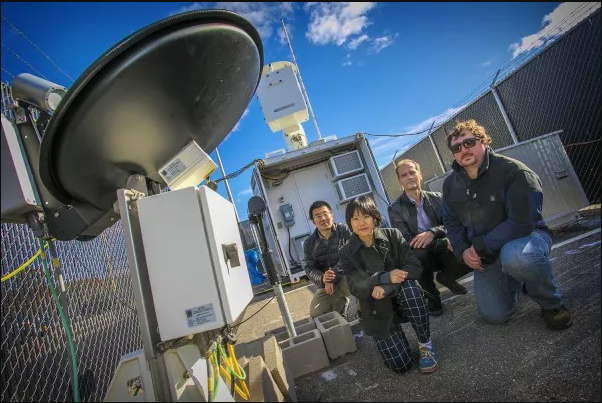Above: Professor Pavlos Kollias, center/back, and colleagues at Stony Brook’s Radar Observatory. From left: Zeen Zhu, SoMAS graduate student; Mariko Oue, postdoctoral research associate, SoMAS; and Alexander Sneddon, SoMAS engineer. Credit: Stony Brook University
From “Future Weather Forecasting: It’s all in the “MRI” of Clouds” on Newswise, January 12, 2018
Newswise — Stony Brook, NY, January 12, 2018 – Analyzing and determining the structure of clouds remains a challenge for scientists trying to forecast weather. A team of researchers at the Stony Brook University School of Marine and Atmospheric Sciences (SoMAS), led by Professor Pavlos Kollias, is using new types of radar in combination with current meteorology technology to take an “MRI” of clouds. In the same way an MRI and other imaging techniques help physicians visualize and understand what is happening within human body parts, an MRI of clouds helps scientists better understand what happens inside clouds.
Clouds are complex, fast evolving, occur over vast areas and as such are difficult to characterize using current technologies. But with these new radar technologies and forecasting techniques, Kollias and colleagues at Stony Brook University and Brookhaven National Laboratory are completing cloud and precipitation research at the SoMAS Radar Observatory that may evolve into a new way to better forecast weather.
“Using these technologies, we can pinpoint and highlight different components of the interior of clouds,” says Kollias. “We can see how precipitation forms and grows in clouds and better predict not only if it will rain or snow, but how much rain or snow may accumulate on the ground.”
He says the goal of the research is to use data from MRIs of clouds to improve the ability of weather modeling to forecast the type of precipitation and amount on the ground with a level of accuracy and precision not reached previously by meteorologists.
The SoMAS Radar Observatory contains a large array of sensors with different viewing perspectives and different sensitivities allowing observation of the horizontal distribution as well as vertical structure of clouds and precipitation. Moreover, the Observatory is uniquely geographically positioned in the center of the Northeast and coastal for study of winter storms.
For more details about Stony Brook’s use of radar and the MRI of clouds, see this video.
About Stony Brook University Stony Brook University is going beyond the expectations of what today’s public universities can accomplish. Since its founding in 1957, this young university has grown to become a flagship as one of only four University Center campuses in the State University of New York (SUNY) system with more than 26,000 students and 2,600 faculty members, and 18 NCAA Division I athletic programs. Our faculty have earned numerous prestigious awards, including the Nobel Prize, Pulitzer Prize, Indianapolis Prize for animal conservation, Abel Prize and the inaugural Breakthrough Prize in Mathematics. The University offers students an elite education with an outstanding return on investment: U.S. News & World Report ranks Stony Brook among the top 50 public universities in the nation. Its membership in the Association of American Universities (AAU) places Stony Brook among the top 62 research institutions in North America. As part of the management team of Brookhaven National Laboratory, the University joins a prestigious group of universities that have a role in running federal R&D labs. Stony Brook University is a driving force in the region’s economy, generating nearly 60,000 jobs and an annual economic impact of more than $4.6 billion. Our state, country and world demand ambitious ideas, imaginative solutions and exceptional leadership to forge a better future for all. The students, alumni, researchers and faculty of Stony Brook University are prepared to meet this challenge.




